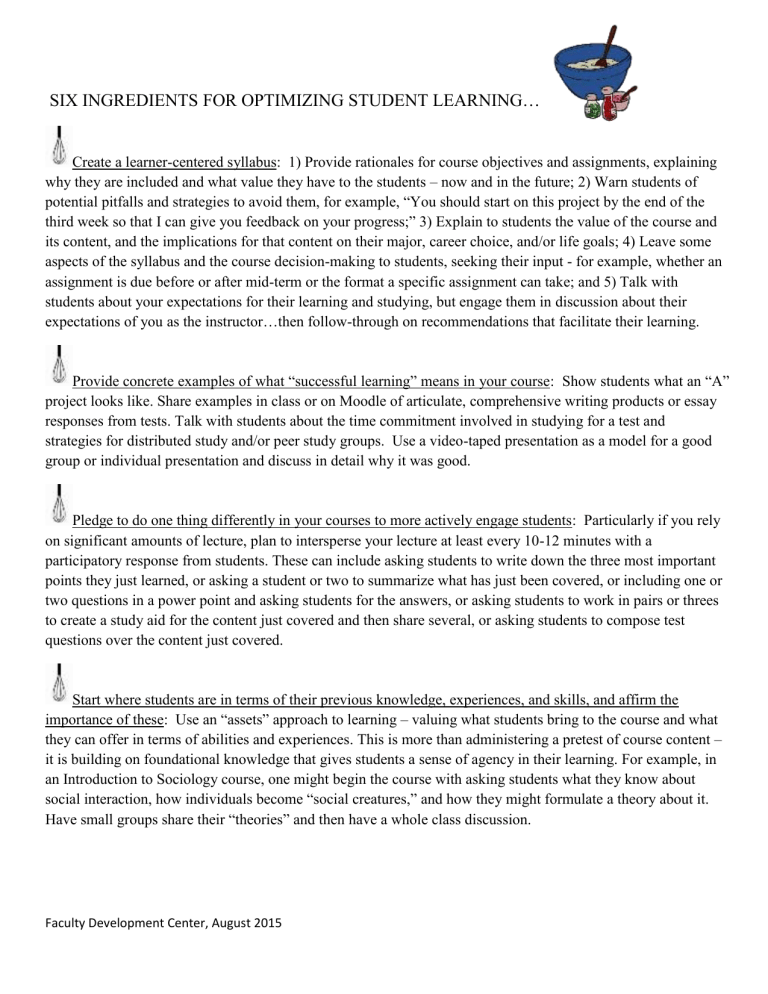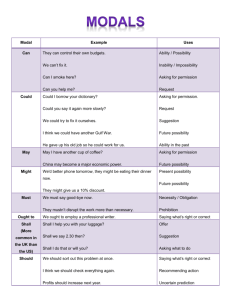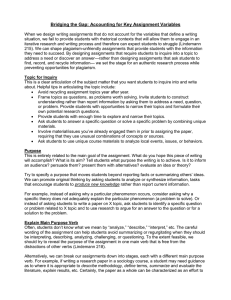Six Ingredients for Student Learning

SIX INGREDIENTS FOR OPTIMIZING STUDENT LEARNING…
Create a learner-centered syllabus: 1) Provide rationales for course objectives and assignments, explaining why they are included and what value they have to the students – now and in the future; 2) Warn students of potential pitfalls and strategies to avoid them, for example, “You should start on this project by the end of the third week so that I can give you feedback on your progress;” 3) Explain to students the value of the course and its content, and the implications for that content on their major, career choice, and/or life goals; 4) Leave some aspects of the syllabus and the course decision-making to students, seeking their input - for example, whether an assignment is due before or after mid-term or the format a specific assignment can take; and 5) Talk with students about your expectations for their learning and studying, but engage them in discussion about their expectations of you as the instructor…then follow-through on recommendations that facilitate their learning.
Provide concrete examples of what “successful learning” means in your course: Show students what an “A” project looks like. Share examples in class or on Moodle of articulate, comprehensive writing products or essay responses from tests. Talk with students about the time commitment involved in studying for a test and strategies for distributed study and/or peer study groups. Use a video-taped presentation as a model for a good group or individual presentation and discuss in detail why it was good.
Pledge to do one thing differently in your courses to more actively engage students: Particularly if you rely on significant amounts of lecture, plan to intersperse your lecture at least every 10-12 minutes with a participatory response from students. These can include asking students to write down the three most important points they just learned, or asking a student or two to summarize what has just been covered, or including one or two questions in a power point and asking students for the answers, or asking students to work in pairs or threes to create a study aid for the content just covered and then share several, or asking students to compose test questions over the content just covered.
Start where students are in terms of their previous knowledge, experiences, and skills, and affirm the importance of these: Use an “assets” approach to learning – valuing what students bring to the course and what they can offer in terms of abilities and experiences. This is more than administering a pretest of course content – it is building on foundational knowledge that gives students a sense of agency in their learning. For example, in an Introduction to Sociology course, one might begin the course with asking students what they know about social interaction, how individuals become “social creatures,” and how they might formulate a theory about it.
Have small groups share their “theories” and then have a whole class discussion.
Faculty Development Center, August 2015
Hold students accountable for their learning and preparation for class: Design assignments so that students must report out on their “homework” at the beginning of class. This can include quizzes over reading assignments, peer review and editing of written assignments, sharing of answers in small groups, collection of an assignment upon entry to the class, and/or “teaching” the other students about an individually assigned section of a text or reading. Consequences for lack of preparation should be clearly explained in the course syllabus and revisited throughout the course. Class format should depend on student preparation, and should become a habitual part of student success in the course.
Provide continuous and meaningful feedback about learning from a variety of sources: Students need to know often and specifically how successful their learning is – from the instructor, from peers, from authentic sources such as professionals in the field, and from themselves in terms of self-assessment. Provide frequent opportunities for formative feedback – including peer evaluation, one-minute written assessments of understanding, a “Can you teach this concept to someone else?” assessment, and a discussion of what would improve your learning – both from a self-reflective perspective and a teaching perspective. When possible, include “outside evaluators,” by having students seek out professionals in their field who can provide feedback on an individual or group assignment. Students should be able to articulate what they are learning continuously over the semester (and beyond).
For more information on “What Faculty Members Can Do” to promote student success in college (by Jillian
Kinzie), see http://nsse.indiana.edu/institute/documents/briefs/DEEP%20Practice%20Brief%206%20What%20Faculty%20
Members%20Can%20Do.pdf
Faculty Development Center, August 2015








